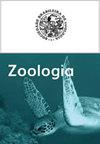Two new species of monogenoidean parasites (Platyhelminthes: Neodermata) of ornamental fish of Loricariidae (Siluriformes) from the Xingu River, Brazilian Amazon
IF 1.8
4区 生物学
Q4 ZOOLOGY
引用次数: 0
Abstract
Two new monogenoidean species of Unilatus Mizelle & Kritsky, 1967 found in the gills of loricariids in the Lower Xingu-Iriri rivers are described: Unilatus humboldtii sp. nov. from Baryancistrus niveatus (Castelnau, 1855), Panaque armbrusteri Lujan, Hidalgo & Stewart, 2010, Pseudacanthicus sp. (type-host), and Scobinancistrus aureatus Burgess, 1994; and Unilatus luciarappae sp. nov. from P. armbrusteri. Unilatus humboldtii sp. nov. is distinguished from other congeneric species due to its anterior anchor with well-developed superficial root with depressed or truncated distal portion, and inconspicuous or reduced deep root; anterior bar with posteromedial projection; hooks of pair 1 with dilated shaft comprising 2/3 of the hook length; spiraled male copulatory organ with approximately 16–18 counterclockwise loops. Unilatus luciarappae sp. nov. is characterized by having anterior anchor with well-developed superficial root and reduced deep root, slightly curved shaft, elongated, slightly curved, and tapered point; spiraled MCO with approximately 18–19 counterclockwise loops, with median distal bulbous portion and remaining portion tapered and elongated, comprising 1/4 of the body length; and accessory piece comprising approximately 2/3 of the MCO length. More than fifty years after the description of the type species of Unilatus from an artificial environment (U.S. aquaria), this study represents the first formal record and description of Unilatus species from hosts collected in natural habitats in the Xingu River. Considering the impact of the Belo Monte dam on the formerly pristine conditions of the study region and the importance of loricariids for the ornamental fish trade, we recommend monitoring monogenoidean diversity, parasite-host interaction, as well as the dispersion patterns and pathogenicity of these parasites.巴西亚马逊河新古河观赏鱼科(志留鱼形目)单基因亚目寄生虫二新种(桔形目:新皮目)
本文描述了在新江- iriri河下游的loricariids鳃中发现的两种新的单种目Unilatus Mizelle & Kritsky: Unilatus humboldtii sp. nov.来自Baryancistrus niveatus (Castelnau, 1855), Panaque armbrusteri Lujan, Hidalgo & Stewart, 2010, Pseudacanthicus sp.(类型寄主)和Scobinancistrus aureatus Burgess, 1994;和unatus luciarappe sp. 11 .来自P. armbrusteri。洪堡独角兽与其他同属种的区别在于其前锚具发育良好的浅根,远端凹陷或截短,深根不明显或缩小;前筋带后内侧投影;具有膨胀轴的一对1的挂钩,其长度为挂钩长度的2/3;螺旋状雄性交配器官,大约有16-18个逆时针的环。其特征为前锚,浅根发达,深根缩小,茎微弯,尖长,微弯,尖尖;螺旋状MCO,约有18-19个逆时针环,中间远端为球根部分,其余部分变细拉长,约占体长的1/4;和附件,约占MCO长度的2/3。在人工环境(美国水族)中描述了独角鲨的模式种50多年后,本研究首次正式记录和描述了新古河自然生境中收集的独角鲨物种。考虑到贝罗蒙特大坝对研究区域原有原始环境的影响,以及洛里卡虫对观赏鱼贸易的重要性,我们建议监测单种生物多样性、寄主-寄主相互作用以及这些寄生虫的分散模式和致病性。
本文章由计算机程序翻译,如有差异,请以英文原文为准。
求助全文
约1分钟内获得全文
求助全文
来源期刊

Zoologia
生物-动物学
自引率
0.00%
发文量
15
期刊介绍:
Zoologia, the scientific journal of the Sociedade Brasileira de Zoologia (SBZ), is an international peer-reviewed, open-access Zoological journal that publishes original research on systematics, evolution, taxonomy, nomenclature, biogeography, morphology, physiology, biology, ecology, symbiosis, conservation, behavior, genetics and allied fields. The journal, formerly known as Revista Brasileira de Zoologia, publishes original articles authored by both members and non-members of the Society. The manuscripts should be written exclusively in English.
 求助内容:
求助内容: 应助结果提醒方式:
应助结果提醒方式:


